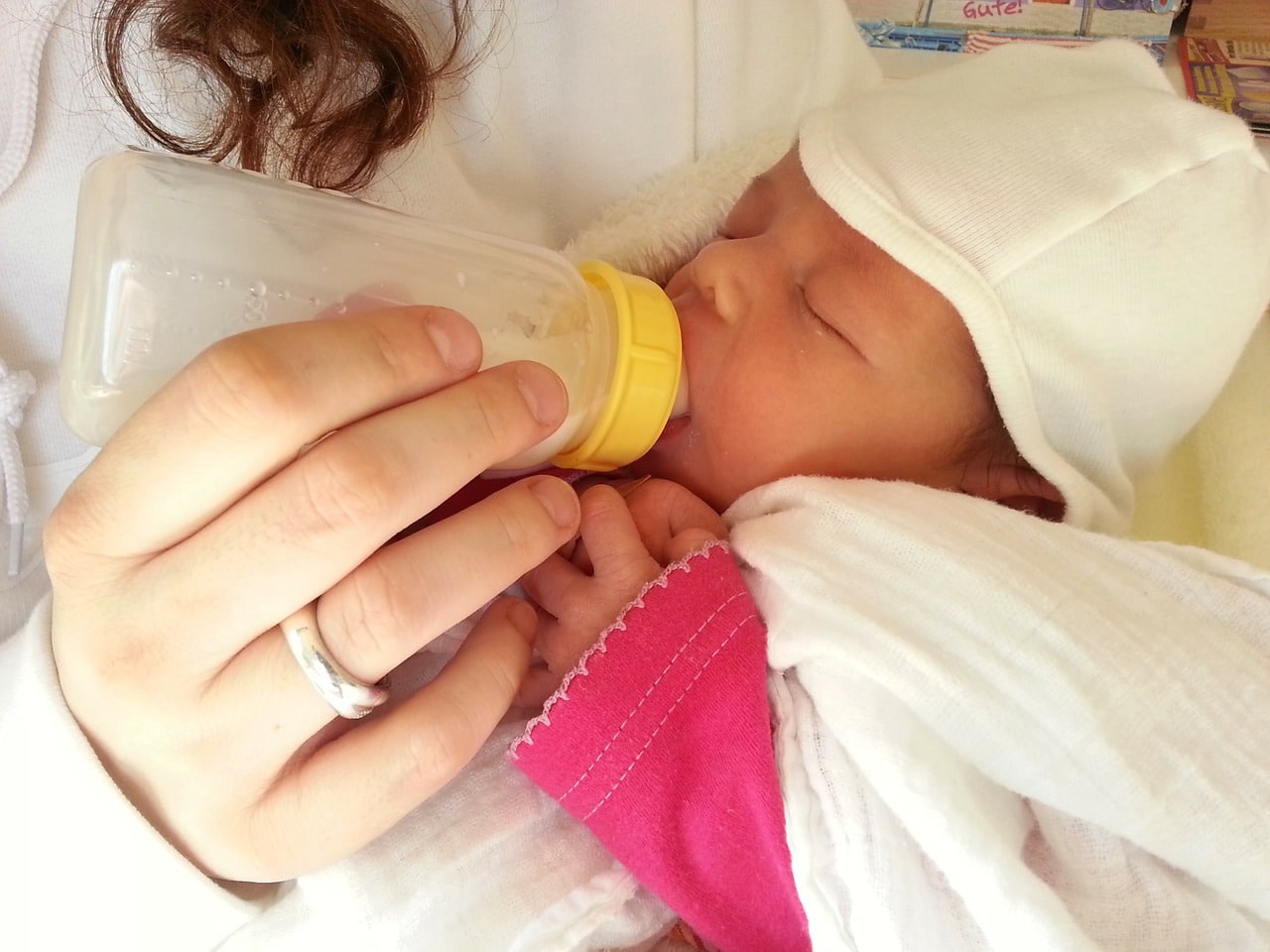What is the perfect amount of milk a baby should drink? That is a difficult question to answer. Babies have different needs and requirements, so it’s hard to give a general number. This post will give you some tips on how much milk your baby should be drinking, depending on their age and weight.
Milk is an important part of a baby’s diet. It provides them with the energy they need to grow and develop, as well as keep their immune system healthy. Because babies are small, it can be difficult for them to get enough milk into their bodies each day. This means that they might need even more than older children or adults do to feel satisfied after drinking this liquid gold!
In This Article
- How much should I feed breast milk or formula to my baby?
- What about the formula given to the baby?
- What is breastfeeding?
- What is formula-feeding?
- What is the best way to feed a baby?
- How do I calculate the milk my baby needs?
- When should you feed your baby?
- How to know if my baby is hungry or not?
- When should I introduce my baby to cow’s milk?
- What about after one-year-old?
- When should I stop giving my baby cow’s milk?
- What about water?
- How do I start making these changes?
- What to do if my baby is underfeeding?
- How to balance the overfeeding?
- How to know whether my baby is eating enough or not?
- What about feeding when going on a trip?
- When to make your baby start having solid foods?
How much should I feed breast milk or formula to my baby?
- The general guideline is about 25-30 ounces of breast milk (750ml – 900ml) per day for your baby up until 12 months old.
- After 12 months of age, you can slowly decrease the amount of milk you give your baby child.
This is because the baby’s energy needs are decreasing, and they should be eating other types of food instead.
There’s no need to force your child to drink the suggested amount every day though! If you feel like they’re drinking too much or not enough then by all means switch it up. The most important thing is that your baby feels satisfied after drinking milk. You can do this by feeding them smaller amounts more often (between meals) rather than large quantities at meal times only – this will satisfy even the hungriest babies!
However, milk intake isn’t just about quantity; quality matters too. It’s best if your little one has full-fat dairy products first before moving on to low-fat options as part of a healthy diet for them in the future. Full-fat dairy is higher in calories, but it can be beneficial to their growth during the first two years of life when they’re still developing and growing fast!
If your baby has more than one serving of milk per day then you should divide up these portions throughout the day so that he or she receives some nutrients at every mealtime. Also, be sure not to feed them any other drinks (like juice) between meals – this will take away from how much your baby drinks overall daily.

What about the formula given to the baby?
Formula feeding shouldn’t replace breastmilk entirely because it doesn’t contain all the nutrients which a baby needs for good health as human milk does, nor do bottle-fed kids get immune benefits either. That being said, you can give your child up to 16 oz. (473ml) of formula per day as long as they are eating other solid foods too – this will provide them with the vitamins and minerals that human milk doesn’t have.
Just keep in mind that if you start bottle feeding your baby then gradually lower how much breast milk you’re giving.
This ensures their digestive system slowly adjusts from one type of food to another without causing discomfort or upset tummies. If you make the switch overnight it could be a shock for your little one and cause problems like diarrhea, vomiting, colic, etc., so always opt for making changes over time instead of whenever.

What is breastfeeding?
Breastfeeding is the best option for babies because it’s easy to digest, helps them build up their immune system, and provides plenty of nutrients. This means that breastfed babies only need about 16 oz. (473ml) per day, while older infants should drink around 24 ounces (710ml). However, newborn babies take half an ounce per feeding for the first few weeks or at least 24 hours period.
Since milk intake differs so much between babies though this isn’t a hard-and-fast rule – if your baby seems happy and content then you can try increasing or decreasing his daily amount as he or she grows!
Remember not to overfeed your little one either; otherwise, they will get lots of extra calories than they need which could lead to obesity later in life. The easiest way to tell whether or not your child should be drinking more or less is by paying attention to how often they’re feeding.
If you feed your baby more than once every three hours during the day then it’s time to cut back, and if your baby isn’t hungry more than twice a day then you can try increasing the amount of milk they drink.
What is formula-feeding?
It is using baby formula instead of breastfeeding. The most important thing to remember about formula milk is that it only replaces breast milk – it doesn’t take the place of solid food.
During the first year, the baby still needs breast milk, so you should only give them just enough formula to stay hydrated. Once they’re over the age of one you can start giving them larger amounts to keep up with their growth, but no more than 16 oz. (473ml) per day as milk contains lots of fat and sugar which babies don’t need!

What is the best way to feed a baby?
While breastfeeding is the best option. It’s also natural for mothers, so if you can’t do this then formula feeding is fine too. If you’re bottle-feeding your baby then just remember not to go overboard with the milk – give them up to 16 oz. (473ml) per day and feed them regular meals.
If you’re breastfeeding then just watch how much milk they drink and adjust their intake as they grow.
How do I calculate the milk my baby needs?
- For breastfed babies, you should aim for about 25-30 ounces of milk (750ml – 900ml) per day up until they’re 12 months old.
- At month four, they should have 4 to 6 ounces per feeding.
- After age one, slowly decrease the amount of milk your little one drinks down to 15 ounces per feeding (450 ml). This is because their energy needs are decreasing and they should be eating other types of solid food instead.
- For formula fed babies, you should aim for 16 oz (473ml) per day up until they’re 12 months old, then slowly decrease that amount to about 11oz (325 ml). You can give them no more than one 16-ounce (473ml) serving and two 11-ounce servings (325ml) maximum per day.
This is the general guideline for the milk requirement a baby needs, but you can switch it up if your child is hungry after drinking this amount or not enough satisfied by doing so! Just make sure to feed them smaller amounts more often (every few hours during the day rather than straight away before bedtime) as this will ensure they feel satisfied and enjoy the milk as a nutritious treat!
For more information on how much milk your baby should drink each day or when starting solids, consult with their doctor or research it online. You can also visit authorized sites which have useful tools that help you track and record your child’s daily intake (and other milestones too!) to ensure they’re growing up healthy and strong.
When should you feed your baby?
It’s best to feed your baby or say little one when they seem hungry, not according to a strict schedule. This might be more often at first and then less as time goes on – it all depends on how much milk they’re drinking too!
If you find that there are certain times of day where they’ve been crying or fussy for no reason though (other than being tired) then the next feeding is the perfect chance to try and soothe them instead with some cuddles and comfort.
If your child seems interested in solid food and drinks during non-meal hours but just can’t eat or drink anything because they won’t stop crying then try distracting them with toys, music, etc., until mealtime comes around again. Do whatever you can to help your little one feel better and not so grumpy!
How to know if my baby is hungry or not?
Below are the signs that you can look for, to know whether your baby is hungry or not-
- Crying or fussing for no reason
- Licking their lips
- Opening their mouth again and again
- Sucking whatever they get
- Licking their hands
If you find the above signs then it’s likely that the baby is hungry and needs to be fed! Keep in mind though, feeding your baby doesn’t always mean you have to give them breast milk because other sources of food like veggies and fruit count too.
If your little one is still very young (under 6 months old) then you should first consult with their doctor to see if solids would be a good idea before trying anything out on your own – this way you can make sure the baby gets smoothly transition without any upset tummies etc., occurring.
When should I introduce my baby to cow’s milk?
In most cases you shouldn’t give babies cow’s milk under one year old because they’re not yet ready for this kind of food – breast milk or formula is all that their little tummies need at this age! If your doctor gives you the go-ahead though then start with low-lactose dairy products instead (e.g., cheese) which are easier for them to digest than regular fluid milk and other dairy products.
What about after one-year-old?
After the first birthday, it’s time to introduce your baby to regular milk, but if they’ve never tried this before then be sure not to give them too much at once – even though it tastes good! The lactose in cow’s milk can cause discomfort or an upset tum. It might take a few weeks before anything changes in terms of how much they drink, but eventually, kids will progress onto drinking larger amounts of milk and growing into bigger children!

When should I stop giving my baby cow’s milk?
After your little one turns one year old it’s best to switch them onto regular fluid milk instead – this is because the solid food they eat is sufficient in terms of protein, calcium, and vitamin D.
If you’re still breastfeeding then continue doing so until they want to drop down to just once or twice a day (instead of up to seven/eight times per day on average!) before gradually stopping too; if you have some concerns about how much food your child eats then be sure to ask their doctor what else might help make their meals seem more appealing later on.
What about water?
It’s best to let your child drink plenty of plain, clean tap water when they’re in between meals instead.
Drinking a lot during mealtime isn’t great either since this might make them feel bloated and interfere with how well they eat (and digest) their food too.
How do I start making these changes?
Just like with any diet or new routine, it’s best to ease your baby into drinking less cow’s milk and more water instead. This is because their little tummy might not be ready for changes so soon – in most cases, you’ll need to wait at least two weeks before switching around too much! If they do start showing signs of discomfort, however (e.g., stomach pain), then try giving them less and more often instead of trying to change too much at once!
What to do if my baby is underfeeding?
If your child is underfeeding then it might be a good idea to switch them onto drinking more water instead of milk. This way you might find that they eat better too since the extra fluids make their meals seem bigger and fuller which helps with appetite! If there are any concerns about how much food your baby’s taking in, opt for giving them smaller portions at each mealtime but making sure these are spread out throughout the day instead.
How to balance the overfeeding?
If your child is overfeeding then it might be better to switch them onto drinking less milk instead of more water. This way you can lower the number of calories they’re taking in while still giving them enough liquid so that their tummy doesn’t get too dry or bloated either! It’s best to pick one thing at a time though, and if there are any concerns about how much food your baby eats then opt for smaller portions but make sure these are spread out throughout the day instead.
How to know whether my baby is eating enough or not?
- To know whether your baby is eating enough or not, you can check out their diapers. In the first few months of birth, a baby must have 3-5 wet diapers in a day.
- One can even switch up to growth charts to check out the phenomenon. You can ask the pediatrician about the growth chart as well.

What about feeding when going on a trip?
It’s best to take some milk with you if you know there won’t be any available during the day. This is because breast milk or formula provides plenty of energy for kids even when they don’t eat anything else, but remember that it shouldn’t replace eating solid foods too much either. If you’re worried then opt for taking just enough bottled water along instead of milk – this way nobody will go thirsty no matter how long your journey takes!
Keep in mind though; always make sure there’s somewhere safe nearby where your baby can sit down quietly while they drink their bottle ( cup). Sitting still and drinking can be difficult after a lot of movement and excitement, but it’s the only way to keep your child from spilling their drink or choking on it.
When to make your baby start having solid foods?
You can start introducing solid foods when your baby is between six and seven months old – you’ll know it’s the right time if their gums are strong enough to chew or they’re able to sit up by themselves.
This is even because at this age their bodies and digestive systems are strong enough to take on new types of food, even if these might be a bit harder for them to digest than just plain milk! Make sure you always pick the right kind of food though!
Endnote!
When babies are small, they can not speak up about what they need or want. So, it becomes the duty of the parents to take care of their baby’s needs and requirements. Either you go for breast milk or formula feeding or solid foods, later on, just keep in mind the baby is comfortable during the changes. If any allergies happen at any point in time, then do consult the pediatrician.










![Home Renovation Guide [2025]](/app/uploads/2021/04/design-hacks-1-378x300.jpg)
